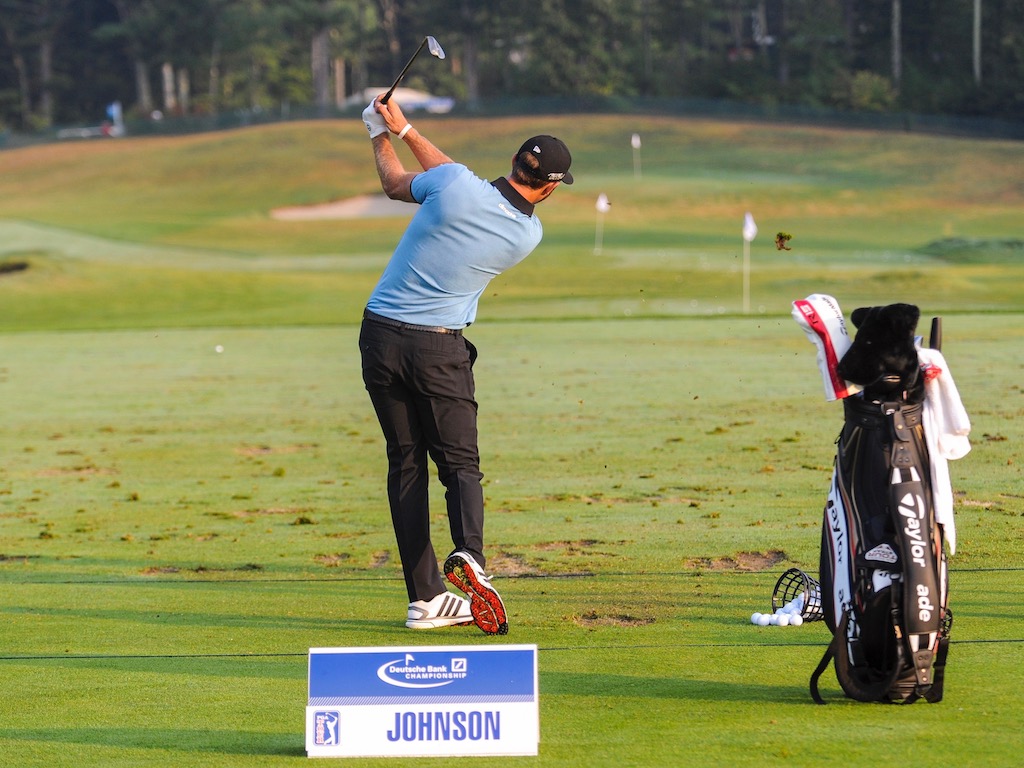Opinion & Analysis
Improve your wedge distance control with Dustin Johnson’s unique drill

Most amateurs understand how important hitting solid wedge shots are for their score. Many of us fail to practice a major factor of effective wedge play, however, distance control.
I was watching Dustin Johnson on the Augusta National range before his Monday practice round with Gary Woodland. Johnson was hitting his driver, and when Dustin Johnson hits his driver on the range you watch. After he finished hitting about 10 drives, he went back to hitting wedges. For the next 45 minutes, he was using a wedge drill I had never seen before. It threw me off because he was not aiming at any particular flag or worrying about how close he could hit a shot to the hole, which is common when practicing wedge play.
Johnson started the drill by finding the yardage to the back of the first green. He hit his first wedge to that yardage. His next shot landed slightly past his first shot, his third longer than his second and so on until he was outside of his wedge yardage. He repeated this process for 45 minutes working on wedge shots from 4o-100 yards. Once he got to 100 yards, he went back to the 40-yard target and restarted the drill.
This drill can be easily repeated by amateurs, even though their cluster of balls will probably not be as tight as Johnson’s. In order to do this on your own, head to your local range and find the yardage to the shortest pin on the range. Once you have it, aim to the left or right of the green in order to have a clear view of the landing area. Try to land a wedge pin high. After you have hit a shot that yardage and established a good starting point, try to land your next shot slightly past of your target ball. Repeat this process until you are out of your wedge range.
While doing the drill, it’s important to keep in mind an estimate of your target yardage so you can start to develop a feel for a 65-yard shot, a 70-yard shot, etc. You may not have a launch monitor behind you on the range like Johnson and a lot of PGA Tour players do, but you can get the data you need with a laser rangefinder or by walking off distances (provided no other golfers are around). In the process, you’ll develop dozens of stock swings for a variety of distances.
Leave a comment if you have any feedback regarding the drill or variations you have found to be successful!
- LIKE315
- LEGIT32
- WOW20
- LOL6
- IDHT5
- FLOP7
- OB3
- SHANK18
19th Hole
Vincenzi’s 2024 Zurich Classic of New Orleans betting preview

The PGA TOUR heads to New Orleans to play the 2023 Zurich Classic of New Orleans. In a welcome change from the usual stroke play, the Zurich Classic is a team event. On Thursday and Saturday, the teams play best ball, and on Friday and Sunday the teams play alternate shot.
TPC Louisiana is a par 72 that measures 7,425 yards. The course features some short par 4s and plenty of water and bunkers, which makes for a lot of exciting risk/reward scenarios for competitors. Pete Dye designed the course in 2004 specifically for the Zurich Classic, although the event didn’t make its debut until 2007 because of Hurricane Katrina.
Coming off of the Masters and a signature event in consecutive weeks, the field this week is a step down, and understandably so. Many of the world’s top players will be using this time to rest after a busy stretch.
However, there are some interesting teams this season with some stars making surprise appearances in the team event. Some notable teams include Patrick Cantlay and Xander Schauffele, Rory McIlroy and Shane Lowry, Collin Morikawa and Kurt Kitayama, Will Zalatoris and Sahith Theegala as well as a few Canadian teams, Nick Taylor and Adam Hadwin and Taylor Pendrith and Corey Conners.
Past Winners at TPC Louisiana
- 2023: Riley/Hardy (-30)
- 2022: Cantlay/Schauffele (-29)
- 2021: Leishman/Smith (-20)
- 2019: Palmer/Rahm (-26)
- 2018: Horschel/Piercy (-22)
- 2017: Blixt/Smith (-27)
2024 Zurich Classic of New Orleans Picks
Tom Hoge/Maverick McNealy +2500 (DraftKings)
Tom Hoge is coming off of a solid T18 finish at the RBC Heritage and finished T13 at last year’s Zurich Classic alongside Harris English.
This season, Hoge is having one of his best years on Tour in terms of Strokes Gained: Approach. In his last 24 rounds, the only player to top him on the category is Scottie Scheffler. Hoge has been solid on Pete Dye designs, ranking 28th in the field over his past 36 rounds.
McNealy is also having a solid season. He’s finished T6 at the Waste Management Phoenix Open and T9 at the PLAYERS Championship. He recently started working with world renowned swing coach, Butch Harmon, and its seemingly paid dividends in 2024.
Keith Mitchell/Joel Dahmen +4000 (DraftKings)
Keith Mitchell is having a fantastic season, finishing in the top-20 of five of his past seven starts on Tour. Most recently, Mitchell finished T14 at the Valero Texas Open and gained a whopping 6.0 strokes off the tee. He finished 6th at last year’s Zurich Classic.
Joel Dahmen is having a resurgent year and has been dialed in with his irons. He also has a T11 finish at the PLAYERS Championship at TPC Sawgrass which is another Pete Dye track. With Mitchell’s length and Dahmen’s ability to put it close with his short irons, the Mitchell/Dahmen combination will be dangerous this week.
Taylor Moore/Matt NeSmith +6500 (DraftKings)
Taylor Moore has quickly developed into one of the more consistent players on Tour. He’s finished in the top-20 in three of his past four starts, including a very impressive showing at The Masters, finishing T20. He’s also finished T4 at this event in consecutive seasons alongside Matt NeSmith.
NeSmith isn’t having a great 2024, but has seemed to elevate his game in this format. He finished T26 at Pete Dye’s TPC Sawgrass, which gives the 30-year-old something to build off of. NeSmith is also a great putter on Bermudagrass, which could help elevate Moore’s ball striking prowess.
- LIKE6
- LEGIT1
- WOW1
- LOL0
- IDHT0
- FLOP2
- OB1
- SHANK1
19th Hole
Vincenzi’s 2024 LIV Adelaide betting preview: Cam Smith ready for big week down under

After having four of the top twelve players on the leaderboard at The Masters, LIV Golf is set for their fifth event of the season: LIV Adelaide.
For both LIV fans and golf fans in Australia, LIV Adelaide is one of the most anticipated events of the year. With 35,000 people expected to attend each day of the tournament, the Grange Golf Club will be crawling with fans who are passionate about the sport of golf. The 12th hole, better known as “the watering hole”, is sure to have the rowdiest of the fans cheering after a long day of drinking some Leishman Lager.
The Grange Golf Club is a par-72 that measures 6,946 yards. The course features minimal resistance, as golfers went extremely low last season. In 2023, Talor Gooch shot consecutive rounds of 62 on Thursday and Friday, giving himself a gigantic cushion heading into championship Sunday. Things got tight for a while, but in the end, the Oklahoma State product was able to hold off The Crushers’ Anirban Lahiri for a three-shot victory.
The Four Aces won the team competition with the Range Goats finishing second.
*All Images Courtesy of LIV Golf*
Past Winners at LIV Adelaide
- 2023: Talor Gooch (-19)
Stat Leaders Through LIV Miami
Green in Regulation
- Richard Bland
- Jon Rahm
- Paul Casey
Fairways Hit
- Abraham Ancer
- Graeme McDowell
- Henrik Stenson
Driving Distance
- Bryson DeChambeau
- Joaquin Niemann
- Dean Burmester
Putting
- Cameron Smith
- Louis Oosthuizen
- Matt Jones
2024 LIV Adelaide Picks
Cameron Smith +1400 (DraftKings)
When I pulled up the odds for LIV Adelaide, I was more than a little surprised to see multiple golfers listed ahead of Cameron Smith on the betting board. A few starts ago, Cam finished runner-up at LIV Hong Kong, which is a golf course that absolutely suits his eye. Augusta National in another course that Smith could roll out of bed and finish in the top-ten at, and he did so two weeks ago at The Masters, finishing T6.
At Augusta, he gained strokes on the field on approach, off the tee (slightly), and of course, around the green and putting. Smith able to get in the mix at a major championship despite coming into the week feeling under the weather tells me that his game is once again rounding into form.
The Grange Golf Club is another course that undoubtedly suits the Australian. Smith is obviously incredibly comfortable playing in front of the Aussie faithful and has won three Australian PGA Championship’s. The course is very short and will allow Smith to play conservative off the tee, mitigating his most glaring weakness. With birdies available all over the golf course, there’s a chance the event turns into a putting contest, and there’s no one on the planet I’d rather have in one of those than Cam Smith.

Louis Oosthuizen +2200 (DraftKings)
Louis Oosthuizen has simply been one of the best players on LIV in the 2024 seas0n. The South African has finished in the top-10 on the LIV leaderboard in three of his five starts, with his best coming in Jeddah, where he finished T2. Perhaps more impressively, Oosthuizen finished T7 at LIV Miami, which took place at Doral’s “Blue Monster”, an absolutely massive golf course. Given that Louis is on the shorter side in terms of distance off the tee, his ability to play well in Miami shows how dialed he is with the irons this season.
In addition to the LIV finishes, Oosthuizen won back-to-back starts on the DP World Tour in December at the Alfred Dunhill Championship and the Mauritus Open. He also finished runner-up at the end of February in the International Series Oman. The 41-year-old has been one of the most consistent performers of 2024, regardless of tour.
For the season, Louis ranks 4th on LIV in birdies made, T9 in fairways hit and first in putting. He ranks 32nd in driving distance, but that won’t be an issue at this short course. Last season, he finished T11 at the event, but was in decent position going into the final round but fell back after shooting 70 while the rest of the field went low. This season, Oosthuizen comes into the event in peak form, and the course should be a perfect fit for his smooth swing and hot putter this week.

- LIKE10
- LEGIT2
- WOW0
- LOL1
- IDHT0
- FLOP1
- OB1
- SHANK1
Opinion & Analysis
The Wedge Guy: What really makes a wedge work? Part 1

Of all the clubs in our bags, wedges are almost always the simplest in construction and, therefore, the easiest to analyze what might make one work differently from another if you know what to look for.
Wedges are a lot less mysterious than drivers, of course, as the major brands are working with a lot of “pixie dust” inside these modern marvels. That’s carrying over more to irons now, with so many new models featuring internal multi-material technologies, and almost all of them having a “badge” or insert in the back to allow more complex graphics while hiding the actual distribution of mass.
But when it comes to wedges, most on the market today are still single pieces of molded steel, either cast or forged into that shape. So, if you look closely at where the mass is distributed, it’s pretty clear how that wedge is going to perform.
To start, because of their wider soles, the majority of the mass of almost any wedge is along the bottom third of the clubhead. So, the best wedge shots are always those hit between the 2nd and 5th grooves so that more mass is directly behind that impact. Elite tour professionals practice incessantly to learn to do that consistently, wearing out a spot about the size of a penny right there. If impact moves higher than that, the face is dramatically thinner, so smash factor is compromised significantly, which reduces the overall distance the ball will fly.
Every one of us, tour players included, knows that maddening shot that we feel a bit high on the face and it doesn’t go anywhere, it’s not your fault.
If your wedges show a wear pattern the size of a silver dollar, and centered above the 3rd or 4th groove, you are not getting anywhere near the same performance from shot to shot. Robot testing proves impact even two to three grooves higher in the face can cause distance loss of up to 35 to 55 feet with modern ‘tour design’ wedges.
In addition, as impact moves above the center of mass, the golf club principle of gear effect causes the ball to fly higher with less spin. Think of modern drivers for a minute. The “holy grail” of driving is high launch and low spin, and the driver engineers are pulling out all stops to get the mass as low in the clubhead as possible to optimize this combination.
Where is all the mass in your wedges? Low. So, disregarding the higher lofts, wedges “want” to launch the ball high with low spin – exactly the opposite of what good wedge play requires penetrating ball flight with high spin.
While almost all major brand wedges have begun putting a tiny bit more thickness in the top portion of the clubhead, conventional and modern ‘tour design’ wedges perform pretty much like they always have. Elite players learn to hit those crisp, spinny penetrating wedge shots by spending lots of practice time learning to consistently make contact low in the face.
So, what about grooves and face texture?
Grooves on any club can only do so much, and no one has any material advantage here. The USGA tightly defines what we manufacturers can do with grooves and face texture, and modern manufacturing techniques allow all of us to push those limits ever closer. And we all do. End of story.
Then there’s the topic of bounce and grinds, the most complex and confusing part of the wedge formula. Many top brands offer a complex array of sole configurations, all of them admittedly specialized to a particular kind of lie or turf conditions, and/or a particular divot pattern.
But if you don’t play the same turf all the time, and make the same size divot on every swing, how would you ever figure this out?
The only way is to take any wedge you are considering and play it a few rounds, hitting all the shots you face and observing the results. There’s simply no other way.
So, hopefully this will inspire a lively conversation in our comments section, and I’ll chime in to answer any questions you might have.
And next week, I’ll dive into the rest of the wedge formula. Yes, shafts, grips and specifications are essential, too.
- LIKE31
- LEGIT7
- WOW1
- LOL1
- IDHT2
- FLOP3
- OB1
- SHANK3
-

 19th Hole2 weeks ago
19th Hole2 weeks agoDave Portnoy places monstrous outright bet for the 2024 Masters
-

 19th Hole2 weeks ago
19th Hole2 weeks agoTiger Woods arrives at 2024 Masters equipped with a putter that may surprise you
-

 19th Hole19 hours ago
19th Hole19 hours ago‘Absolutely crazy’ – Major champ lays into Patrick Cantlay over his decision on final hole of RBC Heritage
-

 19th Hole3 weeks ago
19th Hole3 weeks agoReport: Tiger Woods has ‘eliminated sex’ in preparation for the 2024 Masters
-

 19th Hole1 week ago
19th Hole1 week agoTwo star names reportedly blanked Jon Rahm all week at the Masters
-

 19th Hole7 days ago
19th Hole7 days agoReport: LIV Golf identifies latest star name they hope to sign to breakaway tour
-

 19th Hole1 week ago
19th Hole1 week agoNeal Shipley presser ends in awkward fashion after reporter claims Tiger handed him note on 8th fairway
-

 19th Hole6 days ago
19th Hole6 days agoBrandel Chamblee has ‘no doubt’ who started the McIlroy/LIV rumor and why





















Speedy
Jun 9, 2018 at 9:32 pm
Too many “don’ters” here. Time to be a “doer”.
Luis Pantin
May 20, 2018 at 8:58 am
Buy the Swin Caddie SC200…. this tool is perfect for distance control… and to play games by yourself on the range… and for less than $350 it’s a teacher for life…. this is your 15th club in your bag… you will not regret ever.
I have it and use it as much as I can… it’s a par maker when you lay up …
larrybud
Jun 7, 2018 at 6:35 pm
unfortunately, they’re not that accurate since it can’t measure spin rate or launch angle (only ball speed), and the distances are all calculated from “stock” or average values
Greg V
May 19, 2018 at 10:46 am
Nick Faldo did this with his 7-iron starting at 100 yards. Good drill.
Sin Nombré
May 18, 2018 at 11:41 pm
I asked for a full wedge and the salesman came out with an iceberg salad. It was delicious, but alas, still chili dipping out on the links. Doritos and guacamole anyone?
Mike C
May 18, 2018 at 9:21 pm
This drill is specifically designed for someone using Trackman during practice like DJ does so you know exactly how far the ball is flying. He addresses this in the article but his solution isn’t sufficient.
Mike901550
May 18, 2018 at 5:52 pm
Yep
Until my range has 1. Balls with dimples 2. Balls not covered in mud. 3. Premium balls . It’s a waste of time
Mul
May 18, 2018 at 2:06 pm
Glad I came across this article, I usually just wing it under 100 yards!
TMan
May 18, 2018 at 1:47 pm
Interesting! Iam
going to try this drill. thanks for the information.
stacey
May 18, 2018 at 1:37 pm
Great stuff. I will definitely try this out!
Ty Webb
May 18, 2018 at 12:26 pm
Yeah saw Tom Lehman do this about 25 years ago. Yawn.
DS
May 18, 2018 at 5:11 pm
Did you leave the same douchey comment then too?
One-Iron
May 19, 2018 at 11:27 am
Hahahahaha!
Holdthelag
May 19, 2018 at 4:01 pm
Impressive
Gordon Crossman, PGA of Canada
May 18, 2018 at 12:11 pm
I am a Class “A” Teaching Professional in Canada and I have a drill I call the “Wave”. You take your the most lofted club, take a few practice swings stretch out a bit hit a few balls to get the feeling to start your practice session then you take a full swing with the club without hitting hard and note the landing area then the next ball must land short of the previous shot then the next shot short of the previous one until you can bring it in as close to you as you can by swinging the club as a mini swing. Once you accomplish this you start hitting a little longer by landing the ball pass the previous ball then the next ball pass the previous until you reach the length for that club then repeat the process back and forth like a “Wave” coming in and then going out, this can be done with any club in particular wedges where you may have to loft a shot over a bunker with a tight pin placement, maybe a 15 yard shot. I feel it helps to develop feel plus you create a number of more shots in your bag and it is a fun practice drill to develop feel.
Curtis Demorest
May 18, 2018 at 11:53 am
This is called the ladder drill…can also be used on the putting green. Have a mark at 5 feet then another at 20 feet and see how many balls you can get in the 15 foot area, with each putt going past the previous putt
DB
May 18, 2018 at 11:38 am
Sadly, this WON’T work accurately for most amateurs who are hitting distance-limited or just plain crummy range balls.
It’s good practice for partial wedge swings, but if you think that 65-yard wedge shot you perfected on the range is going to be exactly 65 yards on the course, you might be wrong.
Mower
May 18, 2018 at 11:20 am
I’m on it! “Wedge Guerilla!”